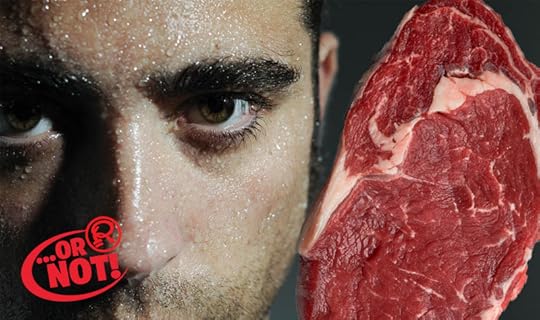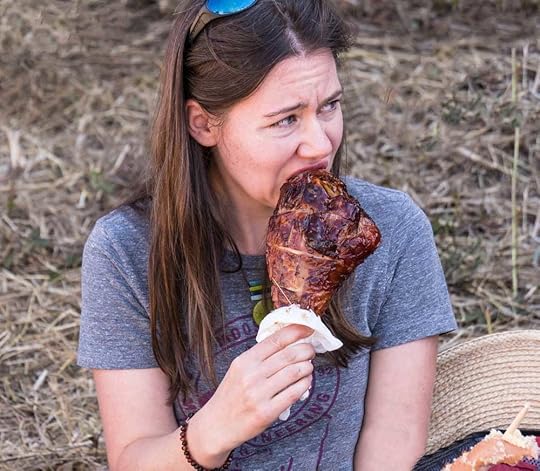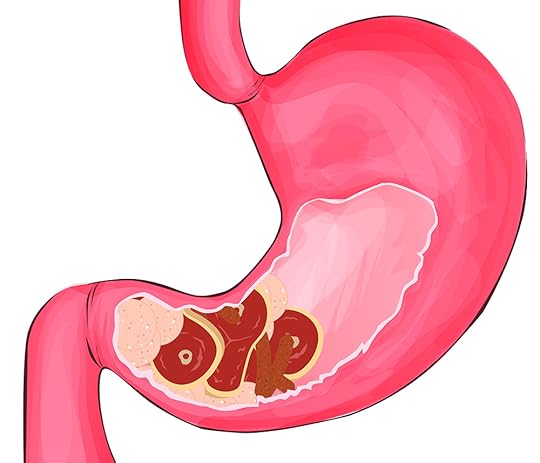Ripley Entertainment Inc.'s Blog, page 361
February 19, 2018
CARTOON 02-19-2018
February 18, 2018
CARTOON 02-18-2018
February 17, 2018
CARTOON 02-17-2018
February 16, 2018
A Pride of Lions Ate a Would-be Poacher
Featured in Ripley's Believe It or Not!

[December 11-17th, 2018] A pride of lions get revenge on a poacher, a lonely frog looks for love, a dog returns home after 10 years, and an adventurer re-discovers the real Beauty and the Beast!
Mullet Festival
The town of Kurri Kurri in Australia is laying claim to the title of “home of the mullet.” To start things off right, they’re holding a competition for the best everyday mullet, best grubby mullet, and best lady’s mullet. The best out of over 50 entrants will represent the best of the iconic “business in the front, party in the back” hairstyle. Participants will be judged on style and stage presence.
Loneliest Frog Seeks Valentine
A reminder that Valentine’s Day is also Singles Awareness Day, workers at the Cochabamba Natural History Museum put out a plea to find a mate for their lonely Bolivian water frog. Highly endangered, the museum has been searching for a female frog for over 10 years. They say that if his quest for love fails, they may have to turn to cloning in order to protect the species.
Dog Back From the Dead
Abby, a black lab, wandered away from her Pittsburg owner’s home in 2008. After a long search, they eventually stopped looking, assuming their dog had sadly passed away. Ten years later, they got a call from the animal shelter saying they had their dog. Abby settled right back into her family as though she had never left, though her decade of adventure remains a mystery.

Alison Teal Re-Discovers Real Beauty and the Beast
Dubbed the “female Indiana Jones” Alison Teal re-traced the steps of Pedro Gonzalez, a sufferer of hypertrichosis—which results in a fur-covered body—who was taken to France and was happily married. Many believe his real-life to have inspired the Beauty and the Beast fairytale.
Lions Eat Poacher
In South Africa’s Kruger National Park, a group of lions have taken revenge on a big cat poacher. The ferocious felines ate the would be cat-killer, much like the Tsavo Man-eaters we covered earlier this week. Poisoned lions with their paws cut off had been recently found in the area, but this group of lions got the better of the poacher, eating nearly all of him.

Yellowstone’s Volcano Could Wipe Us Out! What the Yell?!
Featured in Ripley's Believe It or Not!

Yellowstone National Park has been struck by three massive volcanic blasts—2.1 million, 1.3 million and 640,000 years ago—creating a caldera that spans a whopping 40 miles! Now, the Yellowstone volcano has erupted about every 600,000 to 800,000 years. Given we’re 640,000 years since the last major eruption, in that sweet spot, could it be time for another eruption?
When Will It Erupt?
Yellowstone’s many hydrothermal features attest to the heat brewing below ground, as do earthquakes. Believe it or not, the National Park witnesses 1,000 to 3,000 earthquakes per year!

Yellowstone’s Grand Prismatic Spring, one of the parks many geothermal features, discharges an estimated 560 gallons of 160 °F water per minute!
Recently, geologists have noted an uptick in earthquakes in the area, along with the rising height of the caldera—as much as 2.8 inches per year—both a result of increased magma flow and a potential sign that she’s ready to blow.
But, almost everyone who studies Yellowstone’s super volcano says we have no way of really knowing when the next big blast will happen. The U.S. Geological Survey puts us at 1 in 730,000 odds—about the same chance as a catastrophic asteroid collision. The probability is small, but the consequences are huge!
What Would Happen?

History’s largest landslide occurred during the 1980 eruption of Mount St. Helens.
With little warning, an eruption at Yellowstone could be 6,000 times more powerful than the 1980 Mount St Helens eruption that killed 57 people and sent ash to eleven different states and five Canadian provinces. Like Mount St. Helens, this wouldn’t be a fiery inferno of death (well, it would be for those within a 60 mile radius—they’d be incinerated). Rather a death from above.
Most of the real danger is airborne. Yellowstone’s neighbors would be covered in three feet of volcanic ash and the rest of the country would be dusted coast to coast.
Numerous gases would also be released, including sulfur dioxide, which forms an aerosol that absorbs sunlight, resulting in a cooling effect that would last a decade. This shift would have major impacts on the environment, from altering rainfall to spurring frosts and hindering the ability for plants to photosynthesize—all in all contributing to crop loss and, in turn, widespread famine.
How Can We Prepare?
There isn’t much we can do to prepare, but hopefully we have some time.
Currently, NASA is looking into drilling directly into the Yellowstone caldera, in hopes to release some pressure and reduce the impending explosion’s magnitude.
Cross your fingers for another 100,000 years or so!
Source: Yellowstone’s Volcano Could Wipe Us Out! What the Yell?!
King George’s Blue Urine Gives the Color Royal Blue New Meaning
Featured in Ripley's Believe It or Not!

In 1810, King George III slipped into pure madness and was soon forced to retire from public life completely. He may be best known in the history books for being the king who lost America, but did you know he had blue urine?
Could his mental illness and pools of blue be related? It could all come down to a genetic blood disorder called porphyria.
Driven to Madness

Many historians attribute George’s madness to a genetic blood disorder called porphyria.
The state King George III was in during the last decade of his life forced his son to take the throne. The former king had lost a majority of his sight and was in constant pain. His once worldly and rich vocabulary quickly diminished, as he began constantly repeating himself and writing long, confusing letters.
It is also rumored he would walk around completely nude.
On top of it all, the blue urine…
For Porphyria’s Sake!
In 1969, a study published in Scientific American suggested King George III suffered from porphyria, a disorder caused by an over-accumulation of porphyrin which helps hemoglobin, the protein that moves oxygen throughout the body.
In some cases, porphyrin is excreted in the urine, giving it a purple hue. In rare cases, like George’s, urine is blue.
Acute porphyria can seriously affect the nervous system. Symptoms include hallucinations, delirium, insomnia, anxiety and even paranoia. To top it all off, the king’s doctors might have worsened this condition and its symptoms by treating George with doses of arsenic, basically poisoning him.
With a reputation for being a little off the rails and the flow of a Smurf, the theory of King George III having porphyria leaves you asking if you believe it…or not!
By Ashley Dion, contributor for Ripleys.com
Source: King George’s Blue Urine Gives the Color Royal Blue New Meaning
CARTOON 02-16-2018
February 15, 2018
Meat Sweats Are a Real Thing
Featured in Ripley's Believe It or Not!

Or Not
In today’s world many misconceptions have been perpetuated—becoming modern day “facts”—when, in reality, myths and hearsay have taken over. Sorry to burst your bubble, but in this weekly column, Ripley’s puts those delusions to the test, turning your world upside down, because you can’t always…Believe It!
Today: The meat sweats are real.
Meat Sweats
Have you ever gorged yourself on ribs, wings, hot dogs, or turkey only to experience a rush of heat and perspiration? If you have, you have experienced the phenomenon known as meat sweats.
Avid eaters and food challenge champions attest to the brutal realities of the meat sweats. Some take pre-frenzy antacids, while others claim that exercise after dinging cures the waterworks. Others, however, have given themselves body and soul over, and just wear breathable fabrics and some cologne.
A Meat Hangover
While a plate of wings or smoked turkey leg can indeed evoke a carnivorous frenzy, we wouldn’t really call manic mastication strenuous exercise. Yet, despite this, a mere sniff of roasting meat triggers salivation and sweat.

The phenomenon is so widespread and common that meat aficionados have developed a number of coping strategies. Some swear by pre-meal antacid while others exercise after a bout of feeding. Most, however, have given up on stopping the meat sweats from occurring and just cope with the waterworks, wearing breathable clothing, changing their sheets, or just barreling through by eating more meat.
What Happens to Your Body
When you eat meat, and we mean a lot of meat, your stomach becomes inundated with protein. Protein requires up to seven times the bodily energy to digest than food substances like fat. Energy means heat, and heat means sweat.
The thermal impact of eating is usually negligible, but meat at least has a better chance of raising your core body temperature solely on the fact that it takes more energy to break down. What may be more influential are the metabolism affecting hormones your body produces when you eat.

Incidentally, these hormone responses adapt to your eating habits. This means people get more of the meat sweats when they are eating an unusually large portion of meat. This corroborates the experiences of competitive eaters experiencing pronounced meat sweats.
If you don’t want to sweat through your shirt at the steakhouse, you can try eating a fattier cut, eating less, or just double down on the deodorant and enjoy.
Source: Meat Sweats Are a Real Thing
CARTOON 02-15-2018
February 14, 2018
The Savage Tsavo Man-Eaters and the Man Who Stopped Them
Featured in Ripley's Believe It or Not!

Just east of the famous Kilimanjaro peak, in the unforgiving Tsavo desert, a pair of lions ate a reported 135 people!
Tsavo lions have long been notoriously known as man-eaters. Smaller than their Serengeti brethren west of the mountain, Tsavo lions have smaller manes or no manes at all thanks to their harsher environment. While most lion prides will have a large number of females with a pair of males among them, Tsavo lion groups are smaller, with only one male claiming breeding rights.

Tsavo region lion.
As the salve trading roads developed through Tsavo, many traders pushed their captives hard across the barren wasteland. When a slave died, they were simply left behind, becoming an ample meal for scavenging predators. Many believed this gave the Tsavo lions an early taste for human flesh, one that would be whet for the incoming British in the late 19th-century.
The Ghost and the Darkness
Soon after Lieutenant Colonel John Henry Patterson arrived to lead the construction of a railroad bridge in 1898, lion attacks ravaged his worker’s camp. Striking in the night, a pair of lions with a seemingly insatiable appetite stalked the builders. Screams could be heard in the dead of night as these ferocious predators pulled men from their tents into the wilderness.
Some accounts state that 135 people were eaten by the two lions that year, but company reports place the official figure closer to around 40. This figure, however, didn’t account for any nearby villagers that may have been killed by the lions, making the true number a mystery.
Patterson the Lion Slayer
Lieutenant Patterson, who had hunted tigers in India, was put in charge of stopping the lion’s massacre. He erected thorn barriers, lit bonfires at night, and enacted curfews, but the attacks only seemed to get worse. The workers grew increasingly superstitious and mutinous. It took Patterson months to kill the lions, and upon their deaths, they discovered both were maneless males, rogues without a pride. At over nine feet long each, they were also abnormally larger than other lions in the era, most likely owed to their ample new source of food.

Patterson and one of the man-eaters.
Patterson was immediately proclaimed a hero, restoring faith in his workers and acclaim around the world. The lions were stuffed, eventually making their way to Chicago’s Field Museum of Natural History.

The stuffed Tsavo man-eaters./CC Jeffrey Jung
Modern Study
At the time, much romance and superstition were used to explain the Tsavo man-eaters’ behavior. An incorrigible appetite or taste for human blood was chief among Patterson’s own account of the animals’ reasoning. He surmised that the careless burial practices in the region had meant the lions often scavenged human remains, enticing them to dine on humans.
Since the lions’ remains were preserved, scientists have been able to examine their mouths and discovered that damaged jaws may have accounted for their behavior. With evidence of an abscessed tooth, they believe one of the lions may have had trouble hunting larger prey, and might have been forced to raid the camps for food.
Source: The Savage Tsavo Man-Eaters and the Man Who Stopped Them
Ripley Entertainment Inc.'s Blog
- Ripley Entertainment Inc.'s profile
- 52 followers








